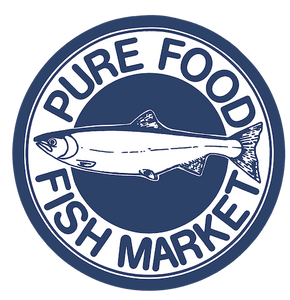FRESH BLOG
For all things Fresh Seafood, cooking inspiration, and more!

An Uncommon Salmon
Cooking the fish connoisseurs crave with a top chef; first catch of a four-week season
I've cooked plenty of fish. But today, my hands nearly tremble as I try to cut into a $34.50-a-pound fillet of Copper River king salmon from south-central Alaska. It's from the season's first major supply of fresh wild salmon and one of the most expensive, exclusive and hyped fish on earth.
My instructor is chef Tom Colicchio. Owner of acclaimed restaurants in New York and elsewhere and head judge on Bravo's "Top Chef" television show, Mr. Colicchio is known for letting pristine ingredients' flavors come through. He appears slightly annoyed at sharing his kitchen with an amateur. I fumble his instructions to cut the salmon "without pushing down on the flesh," so he takes over and slices effortlessly. "This is good fish," he murmurs as he handles the bright orange flesh, stoking my fear of ruining it.
Even among luxurious ingredients, the Copper River king, aka Chinook, comes with a unique set of bragging rights. Along with its slightly less coveted cousin, the Copper River sockeye, it's the first major variety of wild salmon to come to market each year. Its season, which began May 14, lasts just about a month. With lots of flavorful fats, many connoisseurs consider it the world's best salmon.
Just getting your hands on some of the season's first catches is a coup: My Seattle fishmonger, Pure Food Fish, had a waiting list of 70 customers wanting first dibs. The price the morning after the first fish were caught was $39.50 a pound; it dropped $5 later that day, when another planeload came in.
Mr. Colicchio bids me to sniff and caress an 18-pounder he obtained from his own supplier, in order to observe how firm and resilient it is. "What does it smell like?" he asks. When I answer correctly "sea water," I feel we bond a little over fish appreciation.
To best show off the salmon's taste, Mr. Colicchio recommends a simple approach: Using a steel sauté pan, sear one side, flip, add butter and baste the fish nonstop by spooning the butter back over the top. It's a method that works well for any fish, Mr. Colicchio says -- and can be used with chicken or steak, too.
The irony, according to Mr. Colicchio, is that most people who engage in the sport of tracking down this prize mess up their endgame by choosing the thicker part of the fillet over the thinner, sloping portion. "This is better," he says, pointing to abundant lines of white fat that make it, like well-marbled beef, extra succulent.
To me, salmon usually makes for good, but not ecstatic, eating. I explain this to Mr. Colicchio.
"Hopefully this will change your mind," he says as he begins to add chunks of softened butter to the pan. Using a spoon, he tilts the pan towards him and starts cascading burbling butter over the now-golden fish.
It's a lot of butter, but Mr. Colicchio says that even with heavily marbled meat or fish, the outside will dry during the cooking process unless lubricated with fat. Today we're paying homage to this springtime delicacy by garnishing it with seasonal vegetables -- asparagus, peas, rhubarb, chanterelle mushrooms and ramps -- some of which the chef blanches in salted, boiling water. He ladles a quarter cup of this flavorful water into a saucepan, to which he adds more chunks of butter and swirls them together.
"I'm making an emulsion. This is our sauce," he says, allowing me to try my hand at swirling as I breathe in the kitchen's haze of intoxicating briny-butter smell.
When the commercial fishing season opened where the Copper River empties into the Gulf of Alaska, my king was making his way toward the river's treacherous 300-mile course of chilly rapids the fish must traverse like a heat of hurdle jumpers. To survive the journey, it packed on unusual amounts of fat, the good tasting, omega-3-rich variety.
It was ensnared in a gill net, sometime between 7 a.m. and 7 p.m. on that Monday and then bled from an artery and immediately chilled on board the fishing vessel. That kind of careful handling is part of the mystique of the Copper River king, a fish as pampered, managed and marketed as a Hollywood starlet.
By that evening, my salmon had been sold off to one of the big seafood processors in Cordova, Alaska, then loaded onto an Alaska Airlines 737-400 carrying over 24,000 pounds of Copper River king. Sol Amon, the owner of Pure Food Fish, had a man waiting at the Seattle airport for several hundred pounds, which were immediately filleted, divvied up and sold to the customers on the waiting list.
Twenty-five years ago, this all would have sounded like a fish tale to the Copper River fishermen who were selling their catch to canneries for about $1.40 a pound. Then a former fisherman named Jon Rowley sat in a Seattle bar with a bunch of Cordova fishermen in town for a trade show and tried to convince them that he could sell their special salmon to restaurants for big bucks. They would have to gut them, bleed them and chill them on board their vessels, he told them, turning off the majority.
But by 1983, one of the fishermen got into business with Mr. Rowley, who created a Seattle food trend out of Copper River king and went on to spend years promoting it around the country. These efforts captured the imagination of chefs as far flung as Mr. Colicchio, who serves the fish at his flagship Craft restaurants in New York and Dallas.
Before I can again insert myself into the process, Mr. Colicchio has nearly completed assembly of our dish: He bastes the fillet with butter emulsion and adds slices of rhubarb and chanterelle mushrooms, the blanched vegetables and a shaving of lemon peel. He plates it artfully, garnishes with minced chives and hands me a fork.
I spear a chunk of salmon from the thicker part of the fillet. Dripping with the butter emulsion sauce, it's tasty but mirrors my experience with most salmon: Good eating, though nothing revelatory. I look at the chef, forlorn. "Eat here," he says, gesturing with his fork to that thinner, belly part he told me about and from which he is eating.
I take a bite, and there it is: Rich, velvety, tender, and so moist it seems to be spurting juice, like no salmon I ever tasted before. I'm planning to brag.
By KATY MCLAUGHLIN
May 26, 2007
The Wall Street Journal - online

